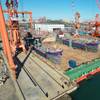Could Coronavirus Disruption Offer an Opportunity for China Shipyards?
A decline in the rate of infections in China provides yards with the opportunity to reorganize their delivery schedules to address an approaching output slump, says Maritime Strategies International (MSI)
The welcome news of declining rates of coronavirus infections in China, together with steps already in place and still to come in terms of government intervention, provide the barest glimmer of good news in the dry bulk market.
But the impact on dry bulk shipping has gone much further than demand; the effects on supply have also been significant given that around 65% of the dry bulk orderbook scheduled for delivery this year is being constructed in China. In its latest Dry Bulk Freight Forecaster, MSI reveals that just a single dry bulk vessel was delivered in China in February, out of a total of 24.
“MSI expects significant slippage in dry bulk deliveries this year but over and above technical factors, the current economic turmoil could offer the yards a chance to reorganize the delivery schedule to help address an arguably bigger problem,” says MSI Dry Bulk Analyst Will Fray. “The orderbook in China is heavily front-loaded and dry bulk shipbuilding activity in the country will drop off a cliff in 2021 unless the schedule is effectively managed.”
Given that three-quarters of the orderbook for 120,000dwt vessels and above is at Chinese yards, MSI believes a significant amount of slippage from the planned Capesize orderbook is inevitable, with just 700,000 dwt delivered on average per month over the next three months.
In comparison, a little over half of the Panamax orderbook for delivery this year is being constructed in China, with most of the remainder in Japan. Chinese shipyards account of 54% of the 2020 Handysize orderbook by deadweight with this orderbook also heavily ‘front-loaded’ suggesting that significant slippage should be expected.
“In the Capesize sector, the delivery schedule is hugely front-loaded, implying a large number of vessels are almost ready for delivery from China. The outbreak of COVID-19 has so far been far less severe in Japan, and we expect to see less slippage in the sub-Capesize segments,” adds Fray. “What remains to be seen is whether shipyards can use the market downturn to manage the flow of tonnage in the face of a low orderbook and weak contracting activity.”















